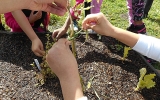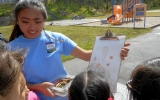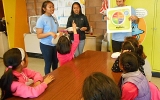
In Daly City, one of the most densely populated cities in California, third graders at Margaret P. Brown Elementary School have planted cherry tomatoes, vegetables, herbs and other plants they hope to harvest by the end of the school year. Hope, of course, is the bond shared by all farmers, big or small.
This spring from Daly City to Redwood City, Colma to San Mateo, gardens are sprouting at elementary schools to help students learn about protein-rich nuts and sweet berries, irrigation and soil science, fitness, fat and fiber.
They are mentored by teenagers trained as Healthy Living Ambassadors in a program run by UC Cooperative Extension and San Mateo County 4-H with financial support from Measure A, the half-cent countywide sales tax approved by voters in November 2012. The Board of Supervisors in September 2015 allocated $60,000 over two years so the program can reach additional schools and students.

Teaching the Teachers
Forty-six teenagers from across San Mateo County spent a weekend in March 2016 at the Elkus Ranch Environmental Education Center near Half Moon Bay. They learned about nutrition, gardening and physical education while building skills as leaders, role models and mentors.
The newly minted Healthy Living Ambassadors are then teamed with students at participating elementary schools. For many Ambassadors and younger students alike, this is their first opportunity to plant a garden and grow their own food. At harvest time, they will make a healthy snack from their garden that all can enjoy.
Seven elementary schools are growing gardens this spring. Six intermediate or high schools have Healthy Living Ambassadors. Find out which schools are participating on our map under "Youth and Education."

Jefferson High School student Ryezelle Felix shows the children their art work. Each student drew a picture of a favorite vegetable.
Making School Lunch Healthier and Taste Better
Each day millions of children across the United States eat lunches provided by their schools. Since passage of the Healthy, Hunger-Free Kids Act of 2010, schools are required to serve meals lower in fat, calories and sodium and richer in proteins, grains and greens.
Yet healthy doesn't always mean tasty. A goal of the Healthy Living Ambassador program is to help schools develop healthier options that kids actually want to eat. Under the terms of the County's grant, UC must survey participant's eating habits and preferences for certain fruits and vegetables. They will use the findings as they help schools develop "smarter lunchrooms" with options that are healthy and tasty.

Healthy Living Ambassadors Ryezelle Felix (left) and Heather Remo (center) encourage the children to talk about their favorite foods as program coordinator Phil Minnick displays the building blocks of a healthy meal.
Reading, Writing and Weeding
School gardens have been around for decades. Teachers use gardens to discuss the cycle of life, the changing of the seasons, science, drought, climate change and a hundred other subjects. But shifts in school resources and a focus on classroom time at the expense of garden time means many go fallow once initial interest wanes.
Healthy Living Ambassadors provide a youth-driven solution for harried teachers and administrators who may support a garden but have little time for one. Ambassadors spend one afternoon a week for eight to 10 weeks at a nearby elementary school nurturing a garden.
Ambassadors are also trained to discuss how food gets from the field to the table and how eating locally grown food cuts down on transportation emissions and supports local jobs. Each of the weekly sessions also includes outdoor play. A key ingredient of living a healthy life is getting plenty of exercise.

"Children who participate in school garden programs are more likely to eat fruits and vegetables and teach their families about healthy eating," said Dr. Scott Morrow, San Mateo County health officer. "Many children in San Mateo County do not have access to healthy food and have never seen how food is grown. Outdoor learning labs give kids real world examples of what healthy eating looks like and support students' health in the long run by integrating health early on."
Published May 5, 2016.
